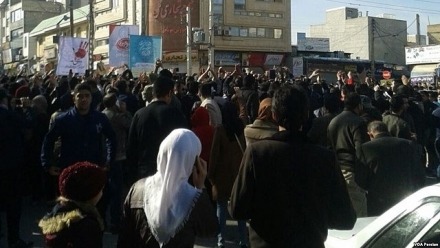Iran protests: Why the Islamic regime and its leaders won't fall so easily

Professor Amin Saikal wrote this article for The Australian Financial Review on 6 January 2018.
The public protests in Iran pose a serious challenge to the ruling clerics and their supporters. But they are unlikely to cause the unseating of the Islamic order, which was established nearly 40 years ago following the Iranian revolution of 1978/79 that toppled the Shah's pro-Western monarchy, enabling the Shah's chief religious and political opponent, Ayatollah Ruhollah Khomeini, to transform Iran into a predominantly Shia Islamic Republic, with an anti-US and anti-Israeli posture. The conditions that gave rise to this development do not exist today, for a number of reasons.
First of all, the Islamic regime is well entrenched, with sufficient coercive resources and public support to neutralise or suppress the protests, just as it dealt with the riots in the wake of the disputed results of the 2009 presidential election. It has at its disposal the highly loyal and powerful Islamic Revolutionary Guard Corps, the para-military organisation of Basij, and an array of other security and intelligence units, all of which have been heavily schooled in Shia Islam as the guardians of the Islamic system. It also enjoys the support of a pervasive cluster of clerics, who have a vested interest in the preservation of the Islamic regime, and who have secured a dominant stake in every facet of Iran's political, social, and economic life. Beyond this, it is popular among certain segments of the population, especially the devout rural Shia citizens. Meanwhile, it has the option of capitalising on the US, Israeli, and Saudi enmity to present the protests as foreign-fuelled - and thus invoke the Iranians' traditional sense of fierce nationalism in the face of outside interference. The Iranians have historically shown an enormous resilience in this respect. These variables stand to cushion the regime against being uprooted easily.
Second, the protests lack leadership, unity of purpose, and organisational strength. Although the anti-Shah revolution was started spontaneously by the monarch's political and professional opponents, Ayatollah Khomeini and his clerical followers ultimately provided what was needed to ensure the success of the revolution. Without Khomeini's leadership and his alternative political vision, and the clerical organisation behind him, the revolution could not have possibly succeeded. It would most likely have taken a direction similar to the early 2011 pro-democracy uprisings in Egypt, which toppled Husni Mubarak's dictatorship, where those instigating the revolt lacked leadership and a common platform. This proved critical in eventually enabling the deep state, led by General Abdel Fattah Al-Sisi and backed by Saudi Arabia and the United Arab Emirates, to return Egypt to authoritarian rule. Currently, there is no national figure to lead the Iranian protesters and no organisational network behind them.
One figure who may command sufficient support among the public to reform the Islamic system of governance is the former reformist President Mohammad Khatami (1997-2005). However, he is marginalised within the ruling clerical stratum, and he has wanted only to reform the Islamic system, not change it. Like other current Iranian leaders, he is very much a product of the system. Whilst Iran's powerful supreme leader, Ayatollah Ali Khamenei, is closely identified with the hardline camp within the Iranian highly factionalised politics, is opposed to any form of dissent, and is deeply resentful of the United States as a 'hegemonic' power, President Hassan Rouhani's stance as a moderate and reformist has not worked either. He was elected for a second term only last June on a reform platform with 24 million votes, but is now caught between the hardline camp and protestors.
Rouhani's efforts to reform the economy, which is badly in need of restructuring and investment, to stamp out corruption, to reduce high unemployment, to ease state theocratic control, and to end all US sanctions have not paid off in terms of tangible improvement in the living standards of a majority of the Iranians. He favourably interacted with the administration of a willing President Barack Obama to conclude the historic nuclear agreement of July 2015, settling the long-running dispute over Iran's nuclear program, but this resulted only in the lifting of America's nuclear-related sanctions. All other US sanctions concerning alleged Iranian support of terrorism, human rights violations, and regional interventionism remained in place. President Donald Trump, who has repeatedly lambasted the Iranian regime as a menace and vowed to reverse the nuclear agreement, has tightened and added to those sanctions. These measures have substantially contributed to growing public frustration, manifesting itself now in the current protests.
Trump and Israeli Prime Minister Benjamin Netanyahu have blatantly backed the protests and urged regime change, but their approach is likely to harm rather than help the cause of the protestors. The two leaders are widely resented in Iran, as they are out of favour around the world. The protestors cannot take heart from their expressions of support, which could backfire by painting them as instruments of Iran's arch enemies.
The public agitation is an Iranian phenomenon with its roots in a set of domestic and foreign policy grievances. Any solution to it needs to emanate from Iran. The US has burned its fingers in Iran before with the CIA-led overthrow of the elected and reformist government of Prime Minister Mohammad Mosaddeq in 1953, and America's subsequent support of the Shah's autocratic rule, which resulted in the loss of Iran as a vital strategic partner. Trump and, for that matter, all US allies should learn from this. He would do a big service to American interests to keep his nose out of the evolving Iranian situation and let the Iranians sort out their own problems.
This article was originally published by The Australian Financial Review on 6 January 2018.









